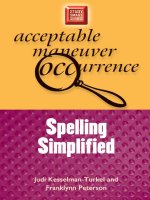ANTIBIOTICS SIMPLIFIED
Bạn đang xem bản rút gọn của tài liệu. Xem và tải ngay bản đầy đủ của tài liệu tại đây (2.19 MB, 289 trang )
ANTIBIOTICSSIMPLIFIED
FOURTHEDITION
JasonC.Gallagher,PharmD,FCCP,FIDSA,BCPS
ClinicalProfessor
TempleUniversitySchoolofPharmacy
Philadelphia,Pennsylvania
ConanMacDougall,PharmD,MAS,BCPS
Professor
UniversityofCalifornia,SanFrancisco–SchoolofPharmacy
SanFrancisco,California
JONES&BARTLETT
LEARNING
WorldHeadquarters
Jones&BartlettLearning
5WallStreet
Burlington,MA01803
978-443-5000
www.jblearning.com
Jones&BartlettLearningbooksandproductsareavailablethroughmost
bookstoresandonlinebooksellers.TocontactJones&BartlettLearning
directly,call800-832-0034,fax978-443-8000,orvisitourwebsite,
www.jblearning.com.
SubstantialdiscountsonbulkquantitiesofJones&BartlettLearning
publicationsareavailabletocorporations,professionalassociations,and
otherqualifiedorganizations.Fordetailsandspecificdiscount
information,contactthespecialsalesdepartmentatJones&Bartlett
Learningviatheabovecontactinformationorsendanemailto
Copyright©2018byJones&BartlettLearning,LLC,anAscendLearning
Company
Allrightsreserved.Nopartofthematerialprotectedbythiscopyrightmay
bereproducedorutilizedinanyform,electronicormechanical,including
photocopying,recording,orbyanyinformationstorageandretrievalsystem,
withoutwrittenpermissionfromthecopyrightowner.
Thecontent,statements,views,andopinionshereinarethesoleexpression
oftherespectiveauthorsandnotthatofJones&BartlettLearning,LLC.
Referencehereintoanyspecificcommercialproduct,process,orserviceby
tradename,trademark,manufacturer,orotherwisedoesnotconstituteor
implyitsendorsementorrecommendationbyJones&BartlettLearning,LLC
andsuchreferenceshallnotbeusedforadvertisingorproductendorsement
purposes.Alltrademarksdisplayedarethetrademarksofthepartiesnoted
herein.AntibioticsSimplified,FourthEditionisanindependentpublication
andhasnotbeenauthorized,sponsored,orotherwiseapprovedbythe
ownersofthetrademarksorservicemarksreferencedinthisproduct.
Theremaybeimagesinthisbookthatfeaturemodels;thesemodelsdonot
necessarilyendorse,represent,orparticipateintheactivitiesrepresentedin
theimages.Anyscreenshotsinthisproductareforeducationaland
instructivepurposesonly.Anyindividualsandscenariosfeaturedinthecase
studiesthroughoutthisproductmayberealorfictitious,butareusedfor
instructionalpurposesonly.
Theauthors,editor,andpublisherhavemadeeveryefforttoprovide
accurateinformation.However,theyarenotresponsibleforerrors,
omissions,orforanyoutcomesrelatedtotheuseofthecontentsofthis
bookandtakenoresponsibilityfortheuseoftheproductsandprocedures
described.Treatmentsandsideeffectsdescribedinthisbookmaynotbe
applicabletoallpeople;likewise,somepeoplemayrequireadoseor
experienceasideeffectthatisnotdescribedherein.Drugsandmedical
devicesarediscussedthatmayhavelimitedavailabilitycontrolledbythe
FoodandDrugAdministration(FDA)foruseonlyinaresearchstudyor
clinicaltrial.Research,clinicalpractice,andgovernmentregulationsoften
changetheacceptedstandardinthisfield.Whenconsiderationisbeinggiven
touseofanydrugintheclinicalsetting,thehealthcareproviderorreaderis
responsiblefordeterminingFDAstatusofthedrug,readingthepackage
insert,andreviewingprescribinginformationforthemostup-to-date
recommendationsondose,precautions,andcontraindications,and
determiningtheappropriateusagefortheproduct.Thisisespecially
importantinthecaseofdrugsthatareneworseldomused.
ProductionCredits
VP,ExecutivePublisher:DavidD.Cella
Publisher:CathyL.Esperti
EditorialAssistant:CarterMcAlister
SeniorVendorManager:SaraKelly
AssociateMarketingManager:AliannaOrtu
VP,ManufacturingandInventoryControl:ThereseConnell
CompositionandProjectManagement:CenveoPublisherServices
CoverDesign:KristinE.Parker
Rights&MediaSpecialist:JameyO’Quinn
MediaDevelopmentEditor:ShannonSheehan
CoverImage:©Triff/Shutterstock
PrintingandBinding:EdwardsBrothersMalloy
CoverPrinting:EdwardsBrothersMalloy
LibraryofCongressCataloging-in-PublicationData
Names:Gallagher,JasonC.,author.|MacDougall,Conan,author.
Title:Antibioticssimplified/JasonC.Gallagher,ConanMacDougall.
Description:Fourthedition.|Burlington,MA:Jones&BartlettLearning,
[2017]|Includesindex.
Identifiers:LCCN2016029350|ISBN9781284111293(spiralbound:alk.
paper)
Subjects:|MESH:Anti-BacterialAgents|Handbooks
Classification:LCCRM267|NLMQV39|DDC615/.7922—dc23
LCrecordavailableat />6048
PrintedintheUnitedStatesofAmerica
201918171610987654321
Contents
Acknowledgments
Introduction
NewtotheFourthEdition
PART1:ConsiderationswithAntibioticTherapy
Chapter1:TheWonderfulWorldofMicrobiology
Chapter2:GeneralApproachtoInfectiousDiseases
Chapter3:AntibioticPharmacokinetics
Chapter4:AntibioticPharmacodynamics
Chapter5:AdverseConsequencesofAntibioticUse
Chapter6:AntibioticResistance
PART2:AntibacterialDrugs
Chapter7:Beta-Lactams
Penicillins
NaturalPenicillins
AntistaphylococcalPenicillins
Aminopenicillins
AntipseudomonalPenicillins
Penicillin/Beta-LactamaseInhibitorCombinations
Cephalosporins
First-GenerationCephalosporins
Second-GenerationCephalosporins
Third-GenerationCephalosporins
Fourth-GenerationCephalosporins
Anti-MRSACephalosporins
Cephalosporin/Beta-LactamaseInhibitorCombinations
Carbapenems
Monobactams
Chapter8:GlycopeptidesandShort-Acting
Lipoglycopeptides
Chapter9:Long-ActingGlycopeptides
Chapter10:Fluoroquinolones
Chapter11:Aminoglycosides
Chapter12:TetracyclinesandGlycylcyclines
Chapter13:MacrolidesandKetolides
Chapter14:Oxazolidinones
Chapter15:Nitroimidazoles
Chapter16:NitrofuransandFosfomycin
Chapter17:Streptogramins
Chapter18:CyclicLipopeptides
Chapter19:FolateAntagonists
Chapter20:Lincosamides
Chapter21:Polymyxins
Chapter22:Fidaxomicin
PART3:AntimycobacterialDrugs
Chapter23:AntimycobacterialDrugs
Chapter24:Rifamycins
Chapter25:Isoniazid
Chapter26:Pyrazinamide
Chapter27:Ethambutol
PART4:AntifungalDrugs
Chapter28:AntifungalDrugs
Chapter29:Polyenes
Chapter30:AntifungalAntimetabolites
Chapter31:Azoles
Fluconazole
Itraconazole
Voriconazole
Posaconazole
Isavuconazole
Chapter32:Echinocandins
PART5:AntiviralDrugs
Chapter33:AntiviralDrugs
Chapter34:Anti-HerpesSimplexVirusandVaricellaZosterVirusAgents
Chapter35:Anti-cytomegalovirusAgents
Chapter36:NeuraminidaseInhibitors
Chapter37:AntiretroviralDrugs
NucleosideandNucleotideReverseTranscriptaseInhibitors
Non-nucleosideReverseTranscriptaseInhibitors(NNRTIs)
ProteaseInhibitors
IntegraseInhibitors
EntryandFusionInhibitors
Chapter38:AntiviralInterferons
Chapter39:Direct-ActingAnti-hepatitisCAgents
Chapter40:Ribavirin
Chapter41:HepatitisBNucleosideAnalogs
PART6:AntiparasiticDrugs
Chapter42:AntiparasiticDrugs
Chapter43:Quinolines
Chapter44:Atovaquone
Chapter45:Benzimidazoles
Chapter46:Pentamidine
Chapter47:Ivermectin
Appendix1:SelectedNormalHumanFlora
Appendix2:SpectrumofActivity
Appendix3:EmpiricRegimensforCommonInfections
Acknowledgments
OurthanksgotothosewhohelpededitallfoureditionsofAntibiotics
Simplified,andtoourwives,whoputupwithusandtookcareofourkids
whilewewrotetheFourthEdition.
WededicatethistexttothepharmacystudentsofTempleUniversityand
UniversityofCalifornia–SanFrancisco.Wehopeyoufindituseful.
Introduction
Antibiotics—thewordsendsterrorcoursingthroughtheveinsofstudentsand
makesmanyhealthcareprofessionalsuncomfortable.Thecategoryof
antibioticsactuallycontainsmanydifferentclassesofdrugsthatdifferin
spectrumofactivity,adverseeffectprofiles,pharmacokineticsand
pharmacodynamics,andclinicalutility.Theseclassescanseembewildering
andbeyondcomprehension.Webelievethattakingalogical,stepwise
approachtolearningthepharmacotherapyofinfectiousdiseasescanhelp
burnawaythementalfogpreventingoptimaluseandunderstandingofthese
drugs.
Learningthecharacteristicsofantibioticsgreatlysimplifieslearninginfectious
diseasepharmacotherapy.Studentsandclinicianswhoattempttolearnthe
antibioticsofchoicefordifferenttypesofinfectionsbeforeknowingthe
characteristicsofthosedrugsnevertrulyunderstandthecontextofwhatthey
areattemptingtolearn.Oncethecharacteristicsoftheantibioticsareknown,
makingalogicalchoicetotreataninfectionismucheasier.Thisapproach
takessometimeupfront,butitwillbewellworththeeffortwhenone
realizesthatthepharmacotherapyofallinfectionsisfundamentallysimilar
andlogical.Italsopaysoffwhenyouencounterapatientwhodidn’treadthe
guidelinesfortheinfectiontheyhaveandrequiresanantibioticregimen
outsideofthenorm.
HowtoUseThisBook
Wewrotethisbookinanefforttocondensethemanyfactsthataretaught
aboutantibioticsinpharmacologyandpharmacotherapycoursesintoone
quickreferenceguide.Itismeanttosupplementmateriallearnedin
pharmacology,nottosupplantit.Usethisbookasareferencewhenyou
encounteraclassofantibioticsthatyouknowyouhaveheardabout;itwill
remindyouofkeypointsyoumayhaveforgotten.
Thisbookcontainssixparts.Part1reviewsbasicmicrobiologyandhowto
approachthepharmacotherapyofapatientwithapresumedinfection.The
chaptersinParts2–6provideconcisereviewsofvariousclassesof
antibacterial,antimycobacterial,antifungal,antiviral,andantiparasiticdrugs.
Again,thisbookisintendedtosupplementyourotherpharmacology
textbooks.Thesechaptersgivekeypointsabouteachclassofantibiotics—
theyarenotthoroughreviews.Theappendicescontainreferencesthatmay
helpindailyuse.
FormatoftheDrugClassReviews
Eachdrugclasschapterfollowsthesamebasicformat.Theagents
belongingtoeachclassarelistedfirst.Thedrugsusedmostcommonlyin
practiceareinbold.
MechanismofAction
Thissectionconciselysummarizesthemechanismofactionoftheantibiotic
class.
Spectrum
Thissectionsummarizeskeyorganismsagainstwhicheachclasshasor
lacksactivity.Thespectralistedarenotexhaustive.
AdverseEffects
Thissectionlistskeyadverseeffects.Thislistisnotexhaustive,butitgives
themostcommonand/orconcerningadverseeffectsofeachclass.
DosingIssues
Thissectiondiscussescommonproblemsorpotentialerrorsindrugdosing
forselectdrugclasseswhentheyarepresent.
ImportantFacts
Thissectionprovidesasummaryofsignificantfactsforandaspectsofeach
drugclass.
WhatThey’reGoodFor
Thissectionlistssomeofthemostcommonand/orusefulindicationsforthe
agentsintheclass.Oftentheagentsdiscussedhavenotbeenapprovedfor
theseindicationsbytheU.S.FoodandDrugAdministration(FDA),butthey
arecommonlyusedforthemanyway.Conversely,manyFDAindicationsthat
theantibioticsdohavearenotlistedhere,becausetheyareoftenout-ofdate.
Don’tForget!
Inthissection,welistpointsthatareoftenoverlookedorespeciallyimportant
whendealingwiththedrugclass.
Asyoureadthisbook,trytothinkofsituationsinwhichtheantibioticswould
beusefultoyourpatients.Thinkofwhyanantibioticisusefulforan
indication;don’tjustlearnthatitis.Itisoursincerehopethatyoutoohave
thatmagicmomentwheretheworldofantibioticsandthestudyofinfectious
diseasesclicktogether.Letusknowwhenithappens.
NewtotheFourthEdition
TheFourthEditionofAntibioticsSimplifiedexpandsonthedrugclasses
coveredinthepreviouseditionswhileretainingthe“keypoint”focusofthe
textthathasmadeitsuccessful.Anewchapter—Chapter6—hasbeen
addedtoPartIto(hopefully)simplifythecomplexnatureofantibiotic
resistance.TheFourthEditionincludesexpandedcoverageofnewagents,
includingtherapidlychangingworldofhepatitisCpharmacotherapy.New
antibioticshavebeenaddedsincetheThirdEdition,andthechaptersfor
eachclasswereupdatedwithnewclinicalandscientificfindings.
PART1:Considerationswith
AntibioticTherapy
1:TheWonderfulWorldof
Microbiology
Despitethepromisesofthehousehold-productsindustry,almostevery
surfaceiscoveredinmicroorganismsalmostallthetime.Swaba
countertop,yourskin,oryourdinnerandyouwillfindalittleworld—andthat
coversonlytheestimated1%ofbacteriathatcanbecultured!Obviously,
tryingtosterilizeourpatients(andourcountertops)isfutile;wehavetotryto
targetthebadorganismsandlettheresthappilycrawlalloverus—they
greatlyoutnumberourowncellsinourownbodiesanyway.
Inthemicrobialworld,bacterialietowardthe“lesslikeus”endofthe
spectrum(Figure1–1).Theyareprokaryotes,noteukaryoteslikefungi,
protozoa,andhumans.Virusesareevenmoredifferentfromus—theyare
basicallyjustapackageofgeneticinstructionsinacell-attackingproteincoat
(Figure1–2).Differencesbetweencellsofmicroorganismsandhumansin
anatomy,biochemistry,andaffinityofantibioticsfortheirtargetsarewhat
allowforthesafeandefficacioususeofantibiotics.Inthissectionwewill
concentrateonthemicrobiologyofbacteria.Discussionoftheunique
characteristicsoffungi,viruses,mycobacteria,andparasiteswillbecovered
inthesectionswhereagentsactiveagainstthoseorganismsareintroduced.
Figure1–1TheMicrobialWorld
Figure1–2RelativeSizesofMicroorganisms
Differentiatingbacteriathatareresponsibleforinfectionfromthosejustalong
fortheridecanbedifficult.Manybacteriathatcancausehumandiseaseare
alsonormalcommensalflora,includingEscherichiacoli,Streptococcus
pneumoniae,andStaphylococcusaureus.Thus,growthofoneofthese
organismsfromacultureisnotnecessarilysynonymouswithinfection.
Suspicionofinfectionisincreasedgreatlyiftheorganismgrowsfroma
normallysterilesite,suchasthebloodstreamorcerebrospinalfluid(CSF).
Indicatorsofinfectioninnonsterilesites(suchassputumandwoundcultures)
areahighnumberoforganisms,presenceofinflammatorycells,and
symptomsreferabletotheculturesite(e.g.,coughordyspneainapatient
withasputumculturegrowingS.pneumoniae,rednessandpaininapatient
withaskinculturegrowingS.aureus).
Definitiveidentificationandsusceptibilitytestingmaytakeanywherefrom
hourstomonths,dependingontheorganismandthemethodsused.
Microscopicexaminationandstainingmayallowforrapidpreliminary
identification.Forbacteria,themostimportantofthesetechniquesisthe
Gramstain.Beingabletointerpretpreliminaryresultsofmicrobiologytesting
willallowyoutoprovidethemostappropriatetherapyforyourpatientsas
earlyaspossible.
Oneofthemostfundamentaldifferencesamongtypesofbacteriaishow
theyreacttoaGramstain.Gramstain(crystalviolet)isasubstancethat
selectivelystainsthecellwallsofGram-positivebacteriabutiseasily
washedawayfromGram-negativebacteria.Why?InGram-positivebacteria,
theoutermostmembraneisathicklayerofpeptidoglycan,acellular
substancethatgivesbacterialcellsrigidity.Incontrast,Gram-negative
bacteriahaveanoutermembraneoflipopolysaccharidethatblocksthestain
fromadheringtothepeptidoglycanwithinthecell(Figure1–3).
Figure1–3CellWallsofGram-PositiveandGram-NegativeOrganisms
RapididentificationofGram-positivebacteriabasedonmorphologyand
preliminarybiochemicaltestscanhelptodirecttherapy.
1. Morphology:MostmedicallyimportantGram-positivepathogensare
cocci(spheres)ratherthanbacilli(rods).ThefindingofGram-positive
bacillishouldbeinterpretedwithintheclinicalcontext:inbloodcultures,
Gram-positivebacillioftenrepresentcommonskincontaminants(such
asPropionibacterium,Corynebacterium,andBacillusspecies),since
theskinbarriermustbebypassedtocollecttheculture.Detectionof
Gram-positivebacillifromnecrotizingwoundinfectionssuggests
clostridialinfection,whereasthefindingofGram-positivebacilliinCSF
culturesraisestheconcernforListeria.
2. Colonyclustering:WithintheGram-positivecocci,thestaphylococci
tendtoformclusters,whereasthestreptococci(includingenterococci)
typicallyappearinpairsorchains.Again,theclinicalcontextaidsin
interpretation:Thefindingofstreptococciinarespiratoryculture
suggestsS.pneumoniae,whileareportof“streptococci”froman
intra-abdominalculturesuggestsEnterococcus(whichmaybe
identifiedpreliminarilyasaStreptococcus).
3. Biochemistryandappearanceonagar:Therapidcatalasetest
helpstodifferentiatestaphylococcifromstreptococci.Thecoagulase
testisusefulfordifferentiatingthemorevirulent(coagulase-positive)
S.aureusfromitscousinthecoagulase-negativeStaphylococcus
epidermidis.S.epidermidisisafrequentcontaminantofblood
cultures;ifonlyoneofapairofbloodsamplesispositivefor
coagulase-negativestaphylococci,treatmentmaynotberequired.The
patternofhemolysis(clearingaroundcoloniesonagarplates)helpsto
differentiateamongthestreptococci:theoralflora(α-hemolyticS.
pneumoniaeandtheviridansstreptococci);pathogensoftheskin,
pharynx,andgenitourinarytract(β-hemolyticGroupAandβstrep);
andthebugsofgastrointestinalorigin(nonhemolyticenterococci:the
morecommonEnterococcusfaecalisandthemoreresistant
Enterococcusfaecium).
Gram-negativesalsocontainpeptidoglycan,butinsmalleramounts,anditis
nottheoutermostlayerofthecell.BothGram-positiveandGram-negative
organismscontainaninnercellmembranethatseparatesthecellwallfrom
thecytoplasmoftheorganism.
Figures1–4and1–5showhowyoucanidentifydifferentbacteriaby
differencesinmorphology,oxygentolerance,andbiochemicalidentification.
Figure1–4Gram-PositiveBacteria
Figure1–5Gram-NegativeBacteria
PreliminaryidentificationissomewhatlessusefulwiththeGram-negative
bacteriabecausemoreextensivebiochemicaltestsareusuallyneededto
differentiateamongthem.
1. Morphology:AmongGram-negativepathogens,thebacilli
predominate.ThesituationinwhichidentificationofGram-negative
cocciismostusefulisinthesettingofmeningitis,wherethisfinding
wouldstronglysuggestNeisseriameningitidis.Notealsothatsome
organismshaveanintermediateor“coccobacillary”appearance,which
maysuggestorganismsofthegeneraHaemophilus,Moraxella,or
Acinetobacter.
2. Glucose/lactosefermentation:Thepathogenswithinthefamily
Enterobacteriaceae(includingE.coli,Klebsiella,Serratia,and
Enterobacter)generallyfermentglucose/lactose;atthispointthelab
mayidentifythemas“entericGram-negativerods”or“lactosefermentingGram-negativerods.”Incontrast,Pseudomonas,
Acinetobacter,Stenotrophomonas,andBurkholderiaare
“nonfermenters”;areportof“nonfermentingGram-negativerods”
shouldleadyoutoreassessandifnecessarybroadenyourantibiotic
coverage,becausemanyoftheseorganismshaveahighlevelof
antibioticresistance.
3. Fastidiousorganisms:Theseorganismsarepickyeaters—they
growslowlyandoftenrequirespeciallysupplementedmedia.Thus,it
maytakeafewdaystoafewweeksforthemtogrowfromculture.
2:GeneralApproachtoInfectious
Diseases
Thepharmacotherapyofinfectiousdiseasesisunique.Inthe
pharmacotherapyofmostdiseases,wegivedrugsthathavesomedesired
pharmacologicactionatsomereceptororproteininthepatient.Totreat
infections,wegiveantibioticstoexertadesiredpharmacologiceffectonthe
organismthatiscausinginfectioninthepatient.Withfewexceptions,direct
effectsonthepatientsfromantibioticsarenotdesiredandareadverse
effects.Itisthethirdpointinthetriangleofinfectiousdiseases
pharmacotherapy,thepathogen,whichmakeseachinfectionineachpatient
unique(Figure2–1).Thefactthatthepharmacotherapyofinfectious
diseasesinvolvesorganismsthatchangeand“fightback”confusesmany
clinicians,buttheapproachtothepatientwithaninfectionisrelativelysimple
andconsistent.Understandingthisapproachisthefirststepindevelopinga
usefulexpertiseininfectiousdiseasesandantibioticuse.
Anote:technicallythetermantibioticrefersonlytoasubsetofantibacterial
drugsthatarenaturalproducts.Thetermsanti-infectiveandantimicrobial
encompassantibacterial,antifungal,antiviral,andantiparasiticdrugs.
However,becauseantibioticisthemorecommonlyusedterm,wewilluseit
torefertoantimicrobialsingeneralorantibacterialsspecifically.
Figure2–1RelationshipsintheInfectedPatient
ProphylacticTherapy
Theuseofantimicrobialchemotherapy—thatis,thetreatmentof
microorganismswithchemicalagents—fallsintooneofthreegeneral
categories:prophylaxis,empiricuse,anddefinitivetherapy.Prophylaxisis
treatmentgiventopreventaninfectionthathasnotyetdeveloped.Useof
prophylactictherapyshouldbelimitedtopatientsathighriskofdeveloping
aninfection,suchasthoseonimmunosuppressivetherapy,thosewith
cancer,orpatientswhoarehavingsurgery.Thesepatientshaveweakened
naturaldefensesthatrenderthemsusceptibletoinfection.Becausethe
likelihoodofinfectionbysometypesoforganismsinthesepatientsishigh
andtheconsequencesofinfectionaredire,weadministerantimicrobialdrugs
topreventinfectionsfromoccurring.However,theworldisnotsterileand
breakthroughinfectionsdooccur.Thekeytounderstandingantimicrobial
prophylaxisistorememberthatpatientswhoreceiveitdonothavean
infection,buttheyareatriskforone.
EmpiricTherapy
Unlikeprophylactictherapy,empirictherapyisgiventopatientswhohavea
provenorsuspectedinfection,buttheresponsibleorganism(s)hasorhave
notyetbeenidentified.Itisthetypeoftherapymostofteninitiatedinboth
outpatientandinpatientsettings.Aftertheclinicianassessesthelikelihoodof
aninfectionbasedonphysicalexam,laboratoryfindings,andothersignsand
symptoms,heorsheshouldgenerallycollectsamplesforcultureandGram
staining.Formosttypesofcultures,theGramstainisperformedrelatively
quickly.IntheGramstain,detailsaboutthesiteofpresumedinfectionare
revealed,suchasthepresenceoforganismsandwhitebloodcells(WBCs),
morphologyoftheorganismspresent(e.g.,Gram-positivecocciinclusters),
andthenatureofthesampleitself,whichinsomecasesindicatesifthe
sampleisadequate.Theprocessofculturingthesamplebeginsaroundthe
timethattheclinicianperformstheGramstain.Afteradayorso,
biochemicaltestingwillrevealtheidentificationoftheorganism,and
eventuallytheorganismwillbetestedforitssusceptibilitytovarious
antibiotics.
However,thisprocesstakesseveraldays,soempirictherapyisgenerally
initiatedbeforetheclinicianknowstheexactidentificationandsusceptibilities
ofthecausativeorganism.Empirictherapyisourbestguessofwhich
antimicrobialagentoragentswillbemostactiveagainstthelikelycauseof
infection.Sometimesweareright,andsometimeswearewrong.Keepin
mindthatempirictherapyshouldnotbedirectedagainsteveryknown
organisminnature—justthosemostlikelytocausetheinfectioninquestion.
Inotherwords,broad-spectrumantibioticsarenotasubstituteforrational
thought!
DefinitiveTherapy
Aftercultureandsensitivityresultsareknown,thedefinitivetherapyphaseof
treatmentcanbegin.Unlikeempirictherapy,withdefinitivetherapyweknow
onwhatorganismstobaseourtreatmentandwhichdrugsshouldwork
againstthem.Atthisphase,itisprudenttochooseantimicrobialagentsthat
aresafe,effective,narrowinspectrum,andcosteffective.Thishelpsus
avoidunneededtoxicity,treatmentfailures,andthepossibleemergenceof
antimicrobialresistance,anditalsohelpsmanagecosts.Ingeneral,moving









